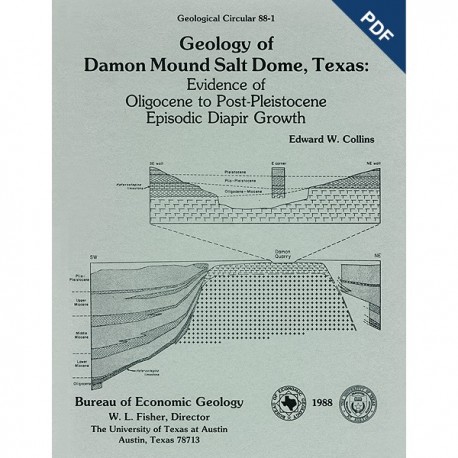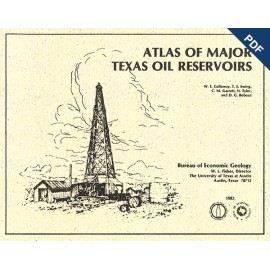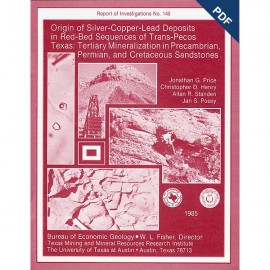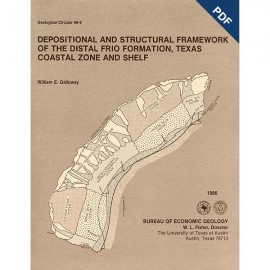Geological Circulars
-
Books & Reports
- Reports of Investigations
- Guidebooks
- Udden Series
- Geological Circulars
- Down To Earth
- Atlases of Major Oil and Gas Reservoirs
- Texas Memorial Museum Publications
- Environmental Geologic Atlas of the Texas Coastal Zone
- Mineral Resource Circulars
- Other Reports
- Seminars and Workshops
- Handbooks
- Submerged Lands of Texas
- Symposia
- Annual Reports
- Open File Reports
-
Maps & Cross Sections
- Thematic Maps
- Miscellaneous Maps, Charts & Sections
- Geologic Atlas of Texas
- STATEMAP Project Maps
- Geologic Quadrangle Maps
- Cross Sections
- Highway Geology Map
- Energy and Mineral Resource Maps
- Shoreline Change and Other Posters
- Wilcox Group, East Texas, Geological / Hydrological Folios
- Bouguer Gravity Atlas of Texas
- River Basin Regional Studies
- Featured Maps
- Posters
- Teachers & the Public
-
Geological Society Publications
- Gulf Coast Association of Geological Societies
- Alabama Geological Society
- Austin Geological Society
- Corpus Christi Geological Society
- Houston Geological Society
- Lafayette Geological Society
- Mississippi Geological Society
- New Orleans Geological Society
- South Texas Geological Society
- GCS SEPM Publications
- Historic BEG & UT Series
Geology of Damon Mound Salt Dome, Texas: Evidence of ...Episodic Diapir Growth. Digital Download
GC8801D
For a print version: GC8801.
GC8801D. Geology of Damon Mound Salt Dome, Texas: Evidence of Oligocene to Post-Pleistocene Episodic Diapir Growth, by E. W. Collins. 24 p., 19 figs., 1 appendix, 1988. doi.org/10.23867/gc8801D. Downloadable PDF.
To purchase this publication in book format, please order GC8801.
ABSTRACT
Damon Mound salt dome, located in Brazoria County, Texas, is a shallow diaper that has salt less than 600 ft (180 m) and cap rock less than 100 ft (30 m) below the surface. Oligocene through Pleistocene strata thin toward the diapir, and the occurrence of a coralline facies of the Oligocene Heterostegina limestone above the cap rock suggests seafloor relief over the diapir during late Oligocene time. Thickening of Miocene and Plio-Pleistocene strata peripheral to the dome suggests syndepositional salt flow from surrounding salt withdrawal subbasins. Some of the sandy Miocene units pinch out domeward, and upper Pleistocene strata are warped over the diapir, causing about 80 ft (25 m) of topographic relief.
Calcite cap rock exposed in Damon Quarry is overlain by Oligocene to Pleistocene deposits. The cap rock is typically brecciated, and calcite veins as well as cavities occur throughout the rock. A block of Oligocene Heterostegina limestone is preserved in the quarry, suggesting that this reef rock was detached from deeper Oligocene beds during diapir growth. Oligocene and Miocene strata are characteristically claystone and siltstone. Three alluvial units compose the Plio-Pleistocene strata exposed in the quarry. A clay-rich lower unit is overlain by two sandy units that represent the upper Pleistocene Beaumont Formation.
Estimated growth rate of Damon Mound since the end of the Oligocene (0.25 ft [0.075 m] per 1,000 yr) is approximately four times less than the apparent growth rate since late Pleistocene deposition (1 ft [0.3 m] per 1,000 yr). This suggests that pulses of varying growth rates probably occurred.
Keywords: Damon Mound, rates of salt dome growth, salt diapirism, salt dome, Texas Gulf Coast, Texas
Citation
Collins, E. W., 1988, Geology of Damon Mound Salt Dome, Texas: Evidence of Oligocene to Post-Pleistocene Episodic Diapir Growth: The University of Texas at Austin, Bureau of Economic Geology Geological Circular 88-1, 24 p. doi.org/10.23867/gc8801D.






